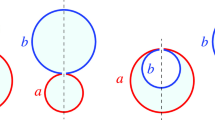Abstract
Equilibrium shapes of vesicles composed of a mixture of partially miscible amphiphiles are investigated. To take into account the influences of the composition, a simple phenomenological coupling between the co mposition and the curvatures, including the mean curvature and the Gauss curvature of the membrane surface, is suggested. By minimizing the potential functional, the general shape equation is obtained and solved analytically for vesicles with simple shapes. Besides, the geometrical constraint equation and geometrically permissible condition for the two-component lipid vesicles are put forward. The influences of physical parameters on the geometrically permissible phase diagrams are predicted. The close relations between the predictions and existing experimental phenomena published recently are shown.
Similar content being viewed by others
References
Canham, P.B.: The Minimum Energy of Bending as a Possible Explanation of the Biconcave Shape of the Human Red Blood Cell, J. Theor. Biol. 26 (1970), 61–81.
Helfrich, W.: Elastic Properties of Lipid Bilayers: Theory and Possible Experiments, Z. Naturforsch.C. 28 (1973), 693–703.
Deuling, H.J. and Helfrich, W.: The Curvature Elasticity of Fluid Membranes: A Catalogue of Vesicle Shapes, J. Phys. France. 37 (1976), 1335–1345.
Seifert, U., Berndl, K. and Lipowsky, R.: Shape Transformations of Vesicles: Phase Diagrams for Spontaneous Curvature and Bilayer-Coupling Models, Phys. Rev. A. 44 (1991), 1182–1202.
Leibler, S.: Curvature Instability in Membranes, J. Phys. France. 47 (1986), 507–516.
Seifert, U.: Configurations of Fluid Membranes and Vesicles, Adv. Phys. 46 (1997), 13–137.
Taniguchi, T., Kawasaki, K., Andlman, D. and Kawakatsu, T.: Equilibrium Shape Deformations of Two-Component Vesicles, J. Phys. II. France. 4 (1994), 1333–1362.
Chen, C.-M., Higgs, P.G. and Mackintosh, F.C.: Theory of Fission for Two-Component Lipid Vesicles, Phys. Rev. Lett. 79 (1997), 1579–1582.
Deuling, H.J. and Helfrich, W.: Red Blood Cell Shapes as Explained on the Basis of Curvature Elasticity, Biophys. J. 16 (1976), 861–868.
Brochard, F., DE Gennes, P.G. and Pfeuty, P.: Surface Tension and Deformations of Membrane Structures: Relation to Two-Dimensional Phase Transitions, J. Physique 37 (1976), 1099–1104.
Iglič, A.: A Possible Mechanism Determining the Stability of Spiculated Red Blood Cells, J. Biomech. 30 (1997), 35–40.
Evans, E. and Rawicz, W.: Entropy-Driven Tension and Bending Elasticity in Condensed-Fluid Membranes, Phys. Rev. Lett. 64 (1990), 2094–2097.
Fourcade, B., Miao, L., Rao, M. and Wortis, M.: Scaling Analysis of Narrow Necks in Curvature Models of Fluid Lipid-Bilayer Vesicles, Phys. Rev. E. 49 (1994), 5276–5286.
Mutz, M. and Bensimon, D.: Observation of Toroidal Vesicles, Phys. Rev. A. 43 (1991), 4525–4527.
Yin, Y., Chen, Y., Ni, D., Shi, H. and Fan, Q.: Shape Equations and Curvature Bifurcations Induced by Inhomogeneous Rigidities in Cell Membranes, J. Biomech (2004), in press.
Ou-Yang, Z.-C. and Helfrich, W.: Instability and Deformation of a Spherical Vesicle by Pressure, Phys. Rev. Lett. 59 (1987), 2486–2488.
Ou-Yang, Z.-C. and Helfrich, W.: Bending Energy of Vesicle Membranes: General Expressions for the First, Second and Third Variation of the Shape Energy and Applications to Spheres and Cylinders, Phys. Rev. A. 39 (1989), 5280–5288.
Yin, Y.: Integral Theorems Based on A New Gradient Operator Derived from Biomembranes (Part II): Deduced Transformations and Applications, Tsinghua Science & Technology, 10(3) (2005), in press.
Yin, Y. and Yin, J.: Geometrical Constraint Equations and Geometrically Permissible Phase Diagrams for Vesicles or Biomembranes, Chin. Phys. Lett. 21 (2004), 2057–2058.
Ou-Yang, Z.-C., Liu, J.-X. and Xie, Y.-Z.: Geometric Methods in the Elastic Theory of Membranes in Liquid Crystal Phases, World Scientific, Singapore, 1999.
Saitoh, A., Takiguchi, K., Tanaka, Y. and Hotani, H.: Opening-up of Liposomal Membranes by Talin, Proc. Natl. Acad. Sci. U.S.A. 95 (1998), 1026–1031.
Yin, Y.: Integral Theorems Based on a New Gradient Operator Derived from Biomembranes (Part II), Tsinghua Science & Technology, 10(3) (2005), in press.
Author information
Authors and Affiliations
Corresponding author
Rights and permissions
About this article
Cite this article
Dong, N., Yajun, Y. & Huiji, S. Equilibrium Shape Equation and Geometrically Permissible Condition for Two-Component Lipid Bilayer Vesicles. J Biol Phys 31, 135–143 (2005). https://doi.org/10.1007/s10867-005-4307-1
Issue Date:
DOI: https://doi.org/10.1007/s10867-005-4307-1




